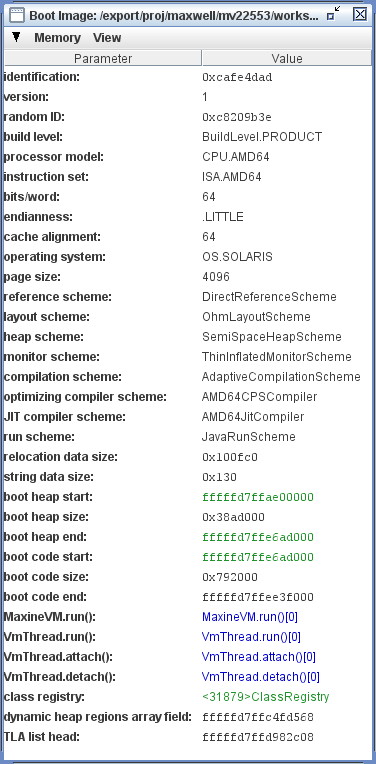Schemes: Interfaces for Maxine VM Configuration¶
The Maxine VM is designed to be highly configurable, and it exploits standard Java language features as much as possible to accomplish this. Maxine schemes are Java interfaces that define the interaction between a subsystem and the rest of the VM.
This design encourages the creation of alternate implementations of those schemes, for example to achieve different performance characteristics. It also enables the creation of specialized implementations for development and testing, for example monitors that have no effect, a heap that doesn’t collect, or any implementation with extensive internal checking and tracing.
The current design of schemes where by all logic is expressed purely in Java code is heavily tied to the use of Java snippets which, in turn, are only supported by the C1X compiler. Given that this compiler is scheduled to be deprecated and replaced by the Graal compiler, the design of schemes will be re-visited to work with Graal.
VM configuration¶
All Maxine schemes extend the interface com.sun.max.vm.VMScheme.
A specific implementation of a scheme is by convention located in its
own package and constitutes a Maxine Package.
It is documented, following Javadoc convention, by a file named
package-info.java in the package directory.
It may also contain a class named Package, which may contain
additional configuration information.
A complete VM configuration includes bindings to a specific
implementation of each scheme, specified as command line options,
processed by the class VMConfigurator, and represented during boot
image generation and VM runtime by an instance of class
VMConfiguration.
The Boot Image Inspector view in the Maxine Inspector displays, among the other information about the specific boot image being viewed, the specific bindings for each of Maxine’s schemes.

Scheme Initialization¶
Each scheme implementation is notified by a call to the method
initialize(MaxineVM.Phase phase) when the VM enters different phases
of its lifecycle.
These phases are defined in the enum Phase in class
com.sun.max.vm.MaxineVM.
Phase BOOTSTRAPPING is assigned during
boot image generation when the
scheme implementation is loaded, something of a misnomer since the term
bootstrapping is generally used to describe the startup
sequence of the VM.
The following list describes the initialization calls that each scheme will receive, in order, during startup, along with the presumed state of the VM in each instance:
PRIMORDIALVM code has started executing, but many features do not work yet.PRISTINEJava thread synchronization has become operational, but may not do anything yet.STARTINGthe VM is functional (i.e. threads and heap), but the JDK is not yet operational.RUNNINGany necessary re-initializion of JDK classes is complete, system properties have been processed, all pure Java language features are operational, and the VM is about to start executing application code.TERMINATINGthe VM is about to terminate, many VM features have shut down, and this the last chance to interpose (but with very limited VM functionality).
Object Layout (LayoutScheme)¶
An implementation of the scheme defined by interface
com.sun.max.vm.layout.LayoutScheme configures how objects are
represented in memory, including header and fields.
See Object layout for more details.
Object References (ReferenceScheme)¶
An implementation of the scheme defined by interface
com.sun.max.vm.reference.ReferenceScheme configures how objects are
accessed for mutator use, for example direct pointers or handles.
The default binding is DirectReferenceScheme.
Note also that the Inspector, which runs in a separate
process than the VM, is able to reuse a considerable amount of VM code
in a uniform way by creating a pseudo-configuration and binding a custom
implementation of ReferenceScheme that encapsulates a boxed address in
the address space of the VM process.
Heap allocation and garbage collection (HeapScheme)¶
An implementation of the scheme defined by interface
com.sun.max.vm.heap.HeapScheme provides basic heap memory management,
object allocation, and garbage collection.
Different implementations may include very different kinds of
collectors.
For example, the default binding is GenSSHeapScheme, which implements
a simple generational collector.
Another binding is SemiSpaceHeapScheme, which implements a
straightforward semi-space collector.
A third heap scheme is the MSHeapScheme, which implements a pure
mark-sweep algorithm.
For certain kinds of testing it can be useful to bind implementations with limited or specialized functionality, for example with an implementation that allocates but never collects or one with extensive heap checking or tracing.
Thread Synchronization (MonitorScheme)¶
An implementation of the scheme defined by interface
com.sun.max.vm.monitor.MonitorScheme supports synchronization in the
VM.
The interface represents an abstraction of monitors.
It specifically includes translation of the monitorenter and
monitorexit bytecodes, as well as the implementation of wait and
notify methods.
Implementations might include thin locks, biased locking, hybrids, etc.
Some experimentation has already been done in this area, and the
implementation currently in use is part of a framework for “n-modal”
locking schemes, a generalization of bimodal (as in JikesRVM) and
trimodal designs.
The framework is implemented by abstract class ModalMonitorScheme in
package com.sun.max.vm.monitor.modal.schemes.
The default binding at present (implemented by class
ThinInflatedMonitorScheme) transitions between thin locks and inflated
native monitors.
For certain kinds of testing it can be useful to disable monitor
checking completely; this can be done by binding the class
IgnoreMonitorScheme into the VM configuration.
VM startup sequence (RunScheme)¶
An implementation of the scheme defined by interface
com.sun.max.vm.run.RunScheme is invoked by the VM after it has started
basic services and is ready to set up and run a language environment
such as Java or some other language.
The default binding is the standard Java runtime: JavaRunScheme (in
package com.sun.max.vm.run.java) starts up normal JDK services (a
somewhat delicate piece of business), and then loads and runs a
user-specified Java class.
Compiler strategy (CompilationBroker)¶
The class com.sun.max.vm.compiler.CompilationBroker implements an
adaptive compilation system with multiple compilers with different
compilation time / code quality tradeoffs.
It encapsulates the necessary infrastructure for recording profiling
data, selecting what and when to recompile, etc.
The class CompilationBroker can be subclassed by using the
max.CompilationBroker.class system property with the boot image
generator.
This is done as follows:
max -J/a-Dmax.CompilationBroker.class=com.acme.MyCompilationBroker image ...
Note: that the CompilationBroker is going to be removed as well
and be replaced by
the JVM Compiler Interface (JVMCI).